Datong is a strange place. For a start, the city centre is partway through being rebuilt. That means that they are knocking down perfectly fine but not very attractive buildings in order to recreate the historic centre… I think it’s being done to make the city more attractive to tourists, but the scale of the work is so huge that it will surely take decades to recoup through tourism the amount being spent on construction.
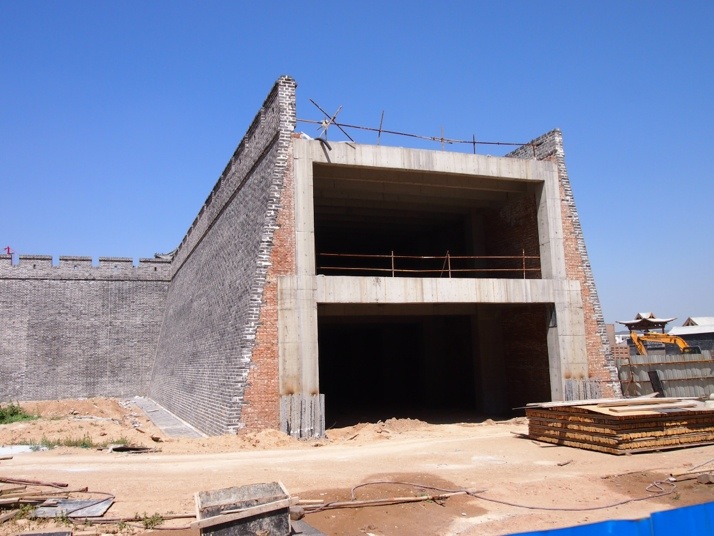 A cross section of the new city wall which is not yet finished
A cross section of the new city wall which is not yet finished
We also felt a little like celebrities here. It’s sufficiently off the beaten path that the locals are very curious about anyone ‘foreign’ looking! I think we’ll encounter this quite often as we travel through China but I don’t know if I’ll get used to it. To give you some idea:
- people would stare at us on the street – I was worried that we might cause an accident as quite a few of those staring were on bicycles
- people looked at us shyly and say ‘hello’ or ‘ni hao’ – us replying generally resulted in a fit of giggles
- more confident locals would stop us to have a chat (usually quite limited by their lack of English and our lack of Mandarin)
- and if they were feeling really confident they would ask if they could take our picture!
Getting there
Getting to Datong was very straightforward. As the train takes about 6 hours we decided that it wasn’t worth doing an overnight trip as we wouldn’t get enough sleep so instead we took the bus which is faster (between 4.5 and 5.5 hours). We were worried about buying our bus ticket but in the end it was more complicated to find out which bus station in Beijing we needed, and how to get there (for anyone having the same difficulties it’s Liuliqiao which can be reached by subway lines 9 or 10). To buy the ticket, we said ‘Datong’ and showed the clerk the Chinese characters for the city name in our guidebook. She turned her screen around and showed us the time of the next bus and the price. Easy peasy. As an added bonus we got views of the Great Wall during the journey which whetted our appetite for when we make the trip there!
Our hostel
We stayed at the brand new Fly by Knight Hostel, the original branch of which is in Beijing. We had a large and comfortable private room with floor to ceiling windows. As the hostel is located on the 22nd floor of a brand new apartment building this means that we had incredible views over the city.
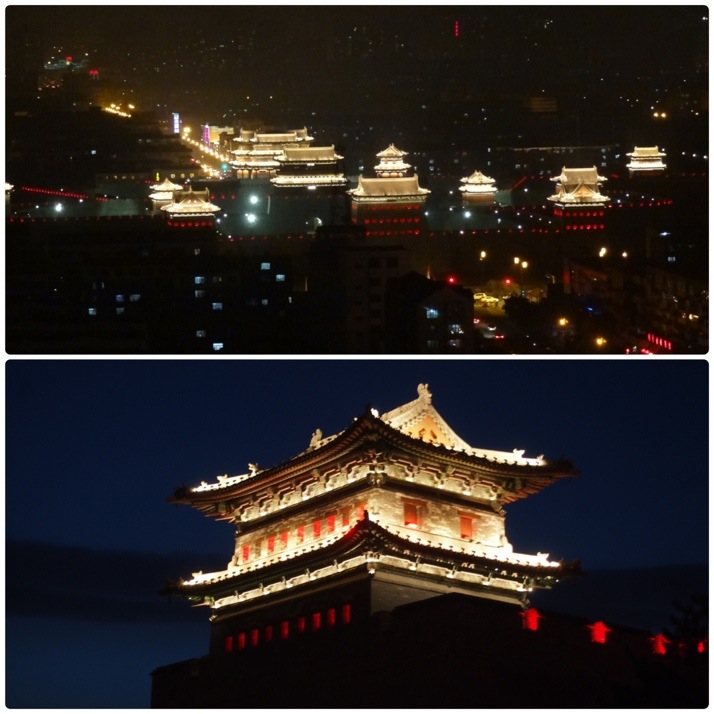 The city walls are lit up at night
The city walls are lit up at night
Sights in the city centre
One of the authentically old parts of the city centre is the Nine Dragon Screen which was built in 1392. According to the information board in the grounds
it was originally situated in front of Dai-king Zhu Gui’s mansion who was the 13th son of Zhu Yuan Zhang, the first emperor of the Ming dynasty.
The mansion has long since gone, but the screen is well worth a quick visit. And yes, the first thing we did was to count the dragons and check that there were nine!
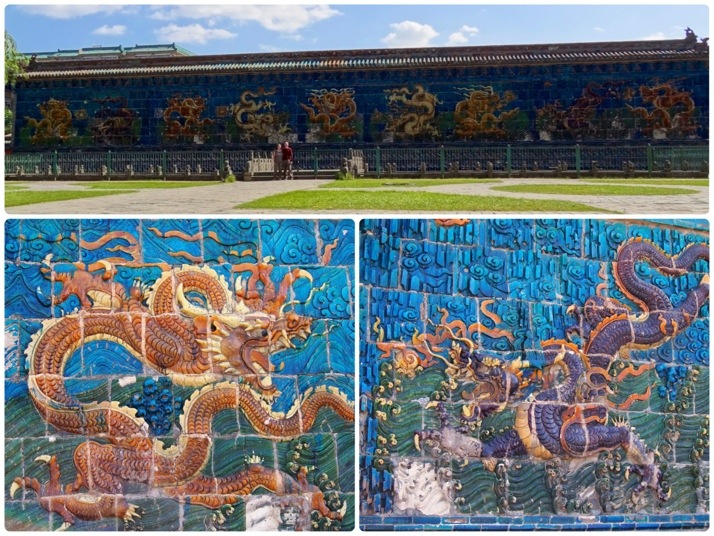 Us in front of the Nine Dragon screen (we really are there in the middle, it’s just very big – 45.5m long!), and two of the dragons
Us in front of the Nine Dragon screen (we really are there in the middle, it’s just very big – 45.5m long!), and two of the dragons
We discovered that it’s also possible to walk on the city walls. Amusingly, the entrance ticket describes them as Ancient City Walls despite the fact that it’s not yet possible to walk all the way around because they haven’t finished building them! It was a nice walk though and we amused ourselves by watching the Chinese tourists on the tandems that are for hire on top of the wall.
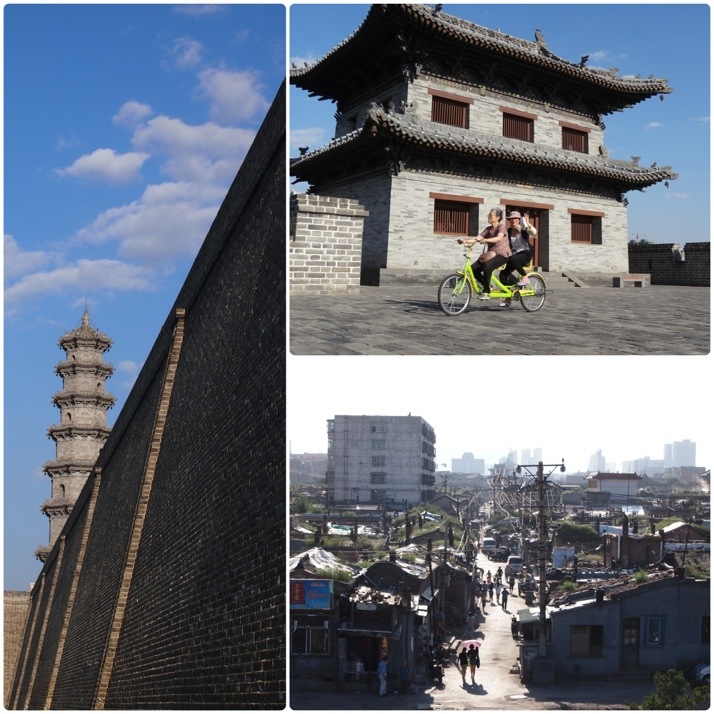 There’s a fake pagoda as part of Datong’s city walls, Chinese tourists on a tandem, and view of a not yet demolished part of the city centre from the walls
There’s a fake pagoda as part of Datong’s city walls, Chinese tourists on a tandem, and view of a not yet demolished part of the city centre from the walls
From Datong there are 2 day trips to major sights which are really the main reason for visiting the city:
Hanging Monastery
The Hanging Monastery is located near the town of Hunyuan, a two hour bus ride from Datong. Again it was easy to buy the bus ticket and the bus driver put us into a taxi for the last 5 minutes to the site of the monastery. If we had been a bit more on the ball we would have tried to communicate to the bus station taxi driver a time when he should come and collect us. Unfortunately, we thought he was just going to hang around, but he was nowhere to be seen when we came back out. We waited to see if he would return (with more tourists from another bus for example), but in the end we had to haggle for a taxi back to Datong – they quoted such a ridiculous price for the 2km to Hunyuan bus station that it just wasn’t worth it. Anyway we had plenty of time to bargain so we were quite pleased to get the price down from 200RMB to 140RMB.
The monastery itself is built into the side of a cliff and dates from 491. It looks as if it’s kind of floating there, as it’s supported by beams drilled into the rock face as well as stilts to the ground. The mountain peak above it protects it from rain and strong winds, and its position 50m from the ground means that it doesn’t get flooded.
The buildings are now just a tourist attraction and there is a prescribed path around the 36 tiny rooms and linking walkways. Some of them are a little precarious and there aren’t many spaces for passing people so we sometimes felt a bit pushed along by the horde of Chinese tourists behind us, but the up close views of the roofs and the building’s quirky structure were worth it. It’s construction is not the only unusual thing about the monastery, it also has elements of all three of the traditional religions: Buddhism, Confucianism, and Taoism.
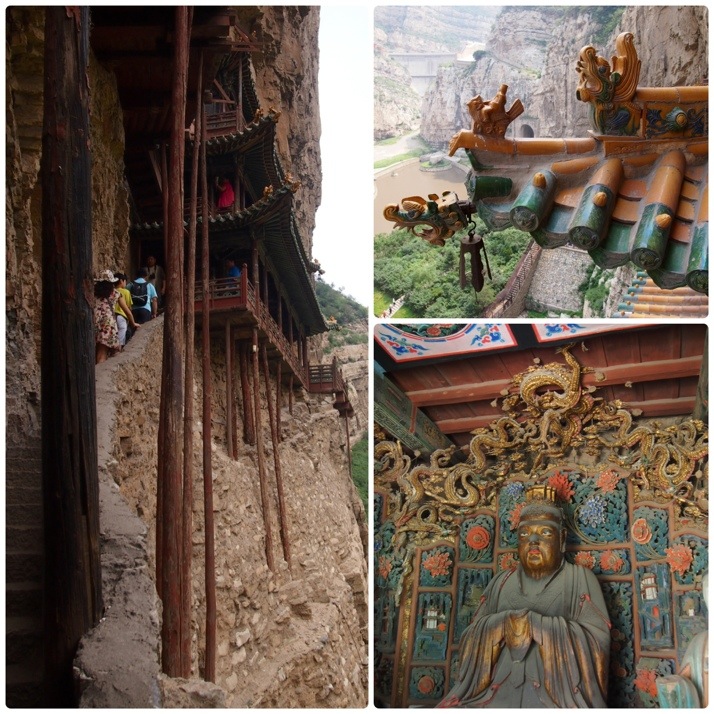 Narrow staircase between levels of the monastery, colourful roof tiles, and inside one of the temples
Narrow staircase between levels of the monastery, colourful roof tiles, and inside one of the temples
Yungang Grottoes
The Yungang grottoes also date from the 5th century and feature Buddhist carvings and paintings in dozens of caves. The cave decorations range from bright wall paintings to huge Buddha statues (some are nearly 20m high). We enjoyed the variety and the scale of the place is really magnificent.
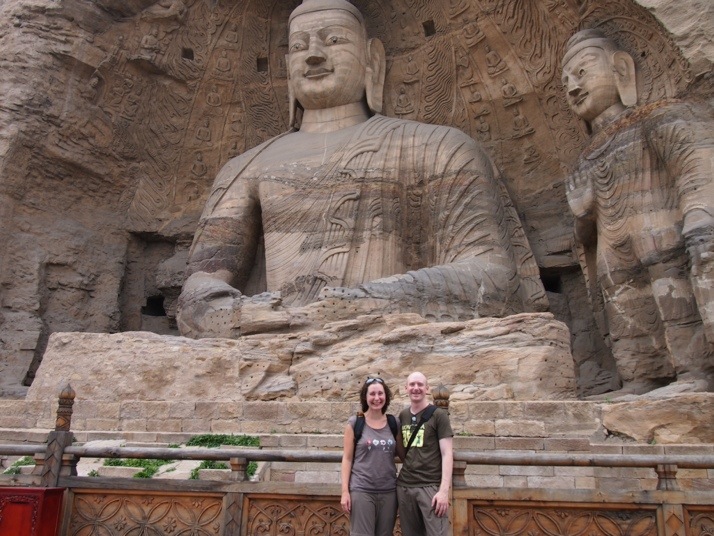 Us in front of the 13.7m high White Buddha (cave no. 20), the cave entrance around this statue has collapsed
Us in front of the 13.7m high White Buddha (cave no. 20), the cave entrance around this statue has collapsed
The caves’ original purpose was of course worship and Buddhist visitors today still burn incense and pray. A new temple has also been built on the site.
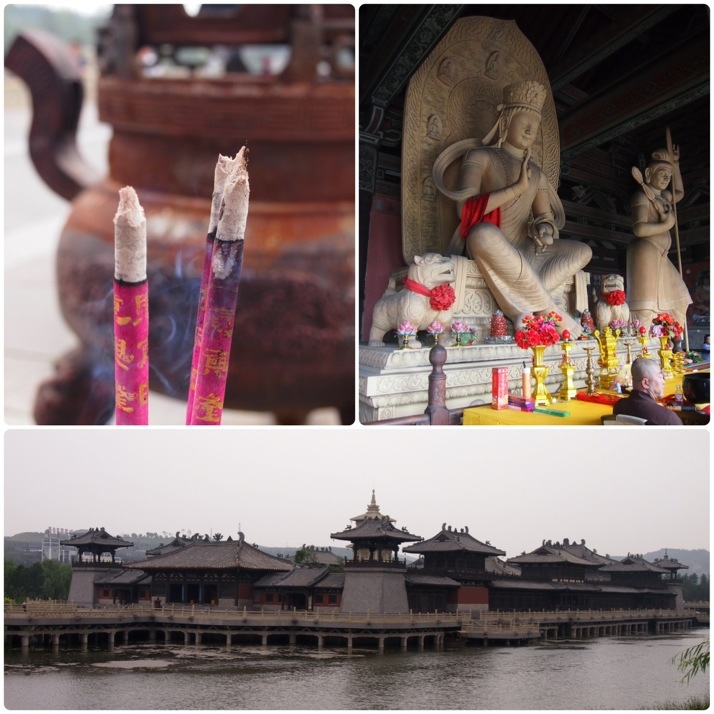 Burning incense, new statues inside the temple, the newly built temple complex is on an island
Burning incense, new statues inside the temple, the newly built temple complex is on an island
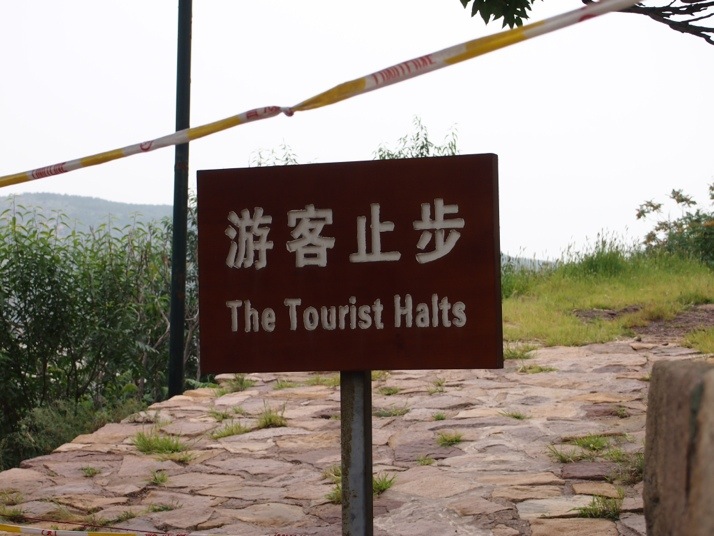 This sign at the end of the walking trail made us chuckle
This sign at the end of the walking trail made us chuckle
Food
We had a bit of trouble finding the Nine Dragon Screen at first and stopped in a local restaurant for lunch and to ask the way (travelling tip for China: copy out the Chinese characters for the sight you want to visit before you leave your hostel, or carry your guidebook with you – showing someone the written Chinese is much easier than the blank look you get if you try to say it). Lunch was potato starch noodles in what looked like chilli soup although it wasn’t actually too spicy. Potato starch noodles are not easy to eat with chopsticks – if I didn’t know better I would think they were made from jellyfish, they’re slimy and gloopy and fall apart when you lift them too high from the bowl! They were surprisingly tasty though.
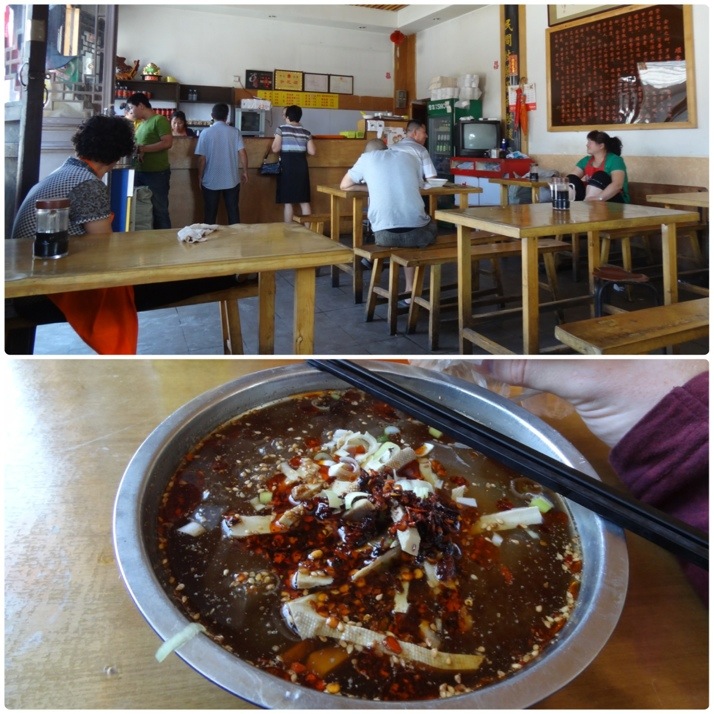 The restaurant, and the noodle soup (the noodles are all lurking below the surface in this picture)
The restaurant, and the noodle soup (the noodles are all lurking below the surface in this picture)
But our favourite place to eat in Datong (we went there every day!) was a street stand just along the road from our hostel. It was run by a husband and wife team. She shaped and cooked bread rolls on a charcoal stove and he shredded the (pre-cooked) pork with mild green chilli and some of the pork cooking gravy to stuff the freshly baked rolls. Delicious!

 two year trip
two year trip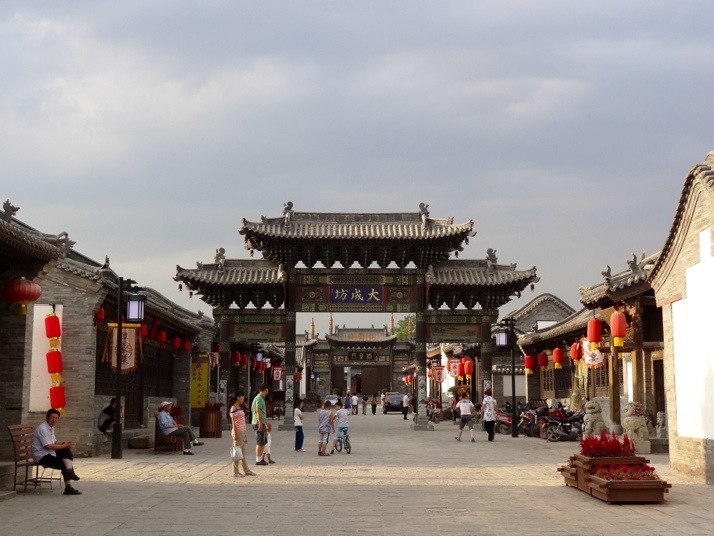
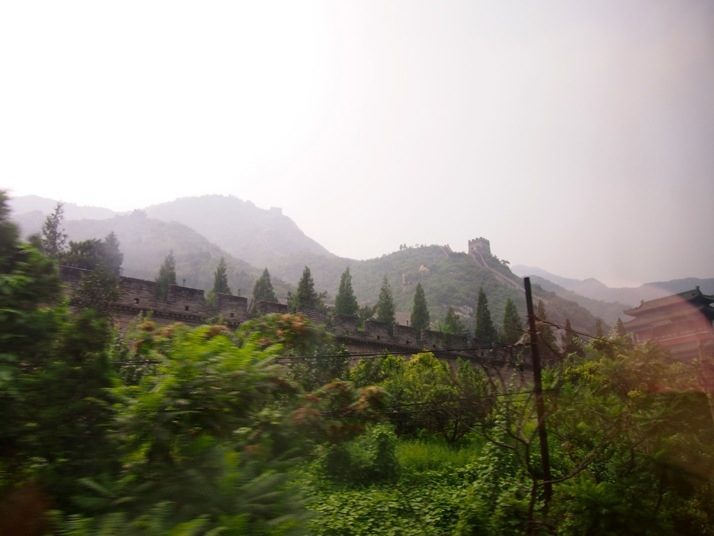
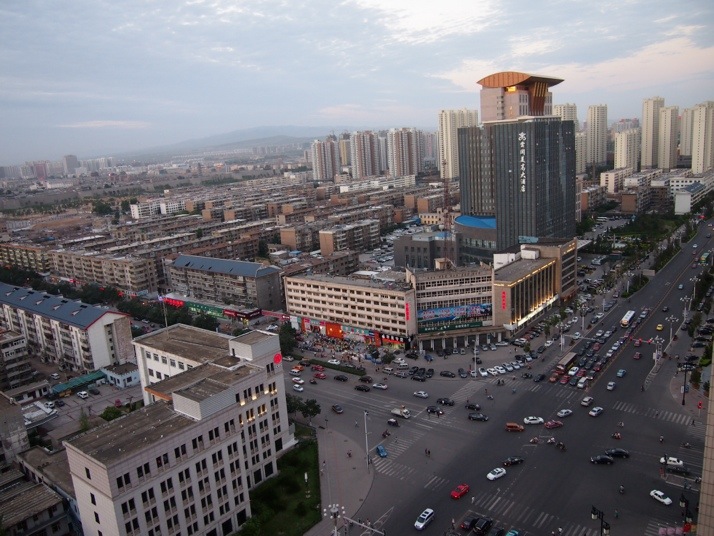
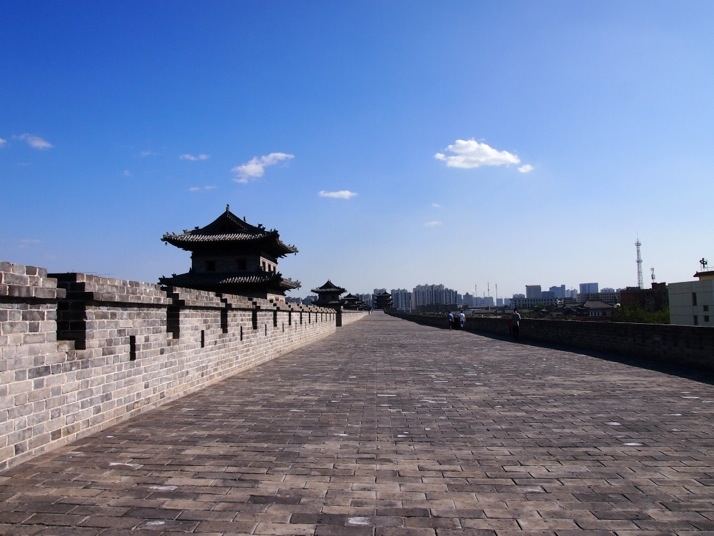
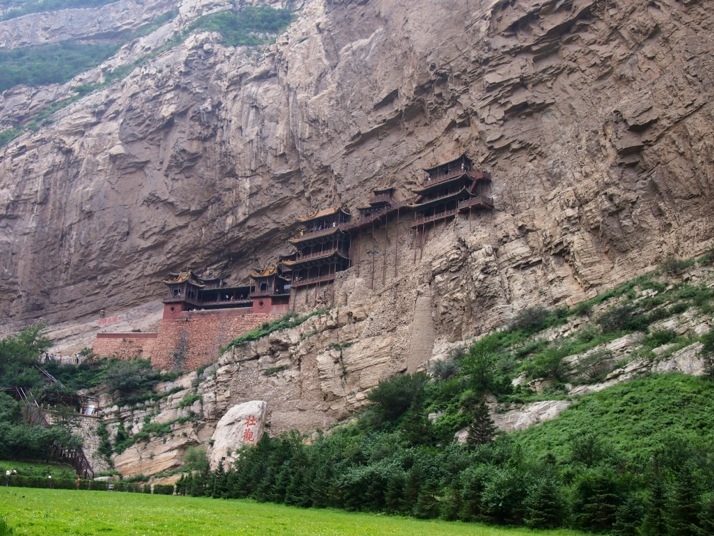
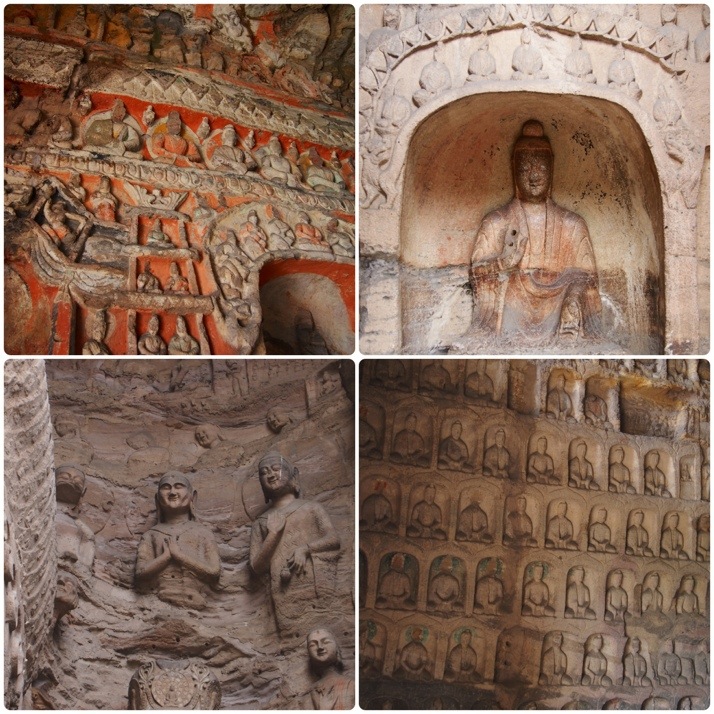
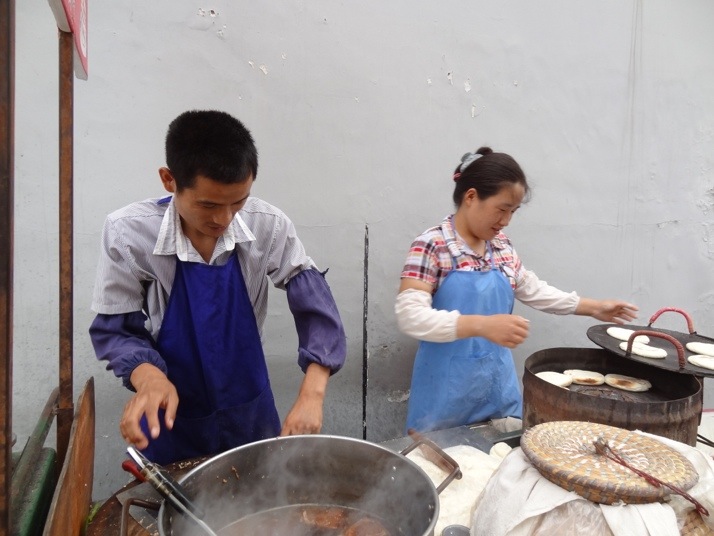
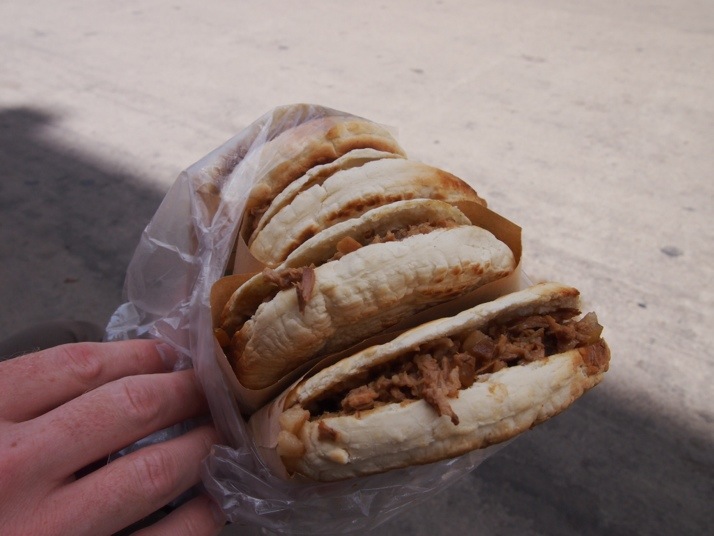
Hi, Julie & Andrew.
It’s Jason of Gobi Desert tour. ;)
It’s nice to see your new posting and to know you guys are doing well in China, too.
Your posting made me recall my short trip to Datong for the Yungang Grottoes & Hanging Monastery several years back.
Best regards,
Jason.
Hi Jason, it’s great to hear from you :)
Julie enjoyed the Yungang Grottoes more, and I liked the Hanging Monastery more – do you have a favourite?
Hi Julie & Andrew !
We met in this very hostel in Datong, i’m the French girl, can you remember me ? (We ate delivered chinese food together).
I am back home in Lyon now, and the simple view of your photos makes me nostalgic about China…and chinese food (never thought i was going to say this a week ago when i was so fed up of noodles). I hope your trip is going well ! I’ll keep reading you !
xx
Hi Yohanna – of course we remember you and Salome, those were some great Chinese takeaway noodles (in China!), and I know what you mean about being fed up, I feel the same about the dumplings :o)
Do you know where you’ll travel to next after you’ve started your studies?
Hi !
Oh it is sad for dumplings, it is so good… After a few weeks back in France I already missed it, even if I was fed up !
We don’t really know what are our next plans with Salomé, we have just found an appartment so we’ll settle here and then think about going again ! But probably around France for first. And my geography studies allow me to travel to Morocco during the year, I’m sooo glad about it !
Hope you and Julie are ok and that the trip goes well !
Ps : I noticed the day after meeting you that your two names Julie and Andrew makes the both of you like the reincarnation of Julie Andrews… The Mary Poppins of travelling ! Ok that was a silly joke sorry about this one :)
Zaijian guys ! xx
Heehee, I think maybe we should add ‘the Mary Poppins of travel’ as the tagline of the blog!
We’re in Hong Kong now and it’s ALL noodles and dumplings but we’re being brave and carrying on somehow :)
Enjoy Morocco – we went a couple of years ago and it’s very beautiful (especially the architecture) but get your bargaining skills ready because you have to haggle for everything…
I found your site searching for some images of Datong’s “old” city wall under construction – which I saw, briefly, when I was there on vacation last year. It’s great to see the cross section! Do you have any more photos posted somewhere?
Hi Evan, it looks like the walls are nearly finished. Did you see they’re building a moat outside the walls too?
We don’t have any more photos of them posted anywhere, but I’ll see if we have any more stashed away and email them to you :)
Hello, my name is Greg and I plan on teaching English in Datong. I was wondering if this is a good place to live for a year? Also, I have a question regarding the pollution around this city; was it quite noticeble? I am quite nervous for this experience due to that I have never visited an Asian culture. Being from the United States really limits us on visiting foreign countries because of the distance between us and the rest of the world besides canada and Mexico. Anyways, I hope you two have some insights for me. Thanks
Greg
Hi Greg,
Thanks for your comment. We were only in Datong for a few days but I think it would be an interesting place to live for a year. There aren’t so many foreign tourists and we found the locals very curious and friendly which makes for some good opportunities to meet people and experience the culture. There are some impressive historical sights nearby which you’ll have seen in our blog post and it’s close enough to Beijing that you could visit for a long weekend or during vacation times.
I don’t remember the pollution being particularly bad in Datong although I think it is quite an industrial area. That said, all the Chinese cities that we’ve visited have much worse air quality than we’re used to in Europe (or the US I imagine) and probably it varies depending on the weather and the season.
It sounds like you’ve got a great opportunity to experience a new culture. In general we found China to be a very safe country, I’m sure you’ll notice plenty of differences to your home town at first but, like us, I expect you’ll start to notice similarities and make connections too.
Good luck with your travels and teaching!
Julie